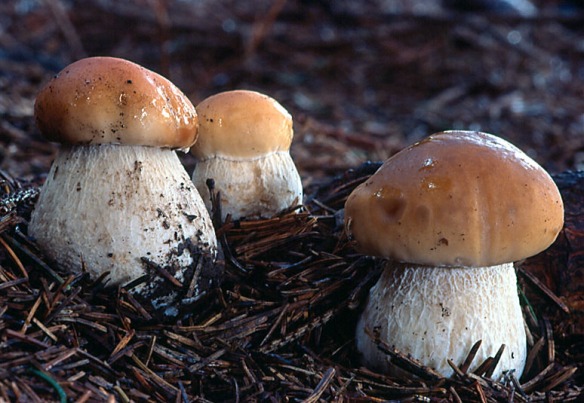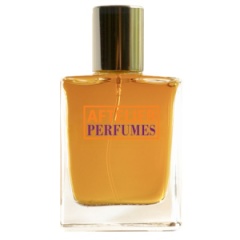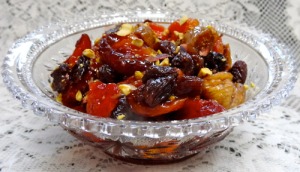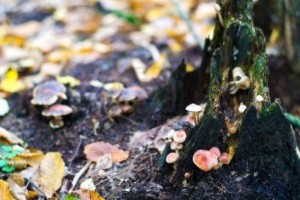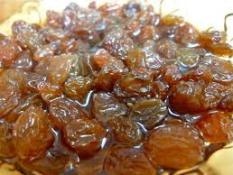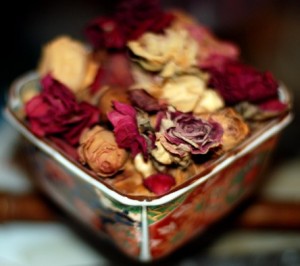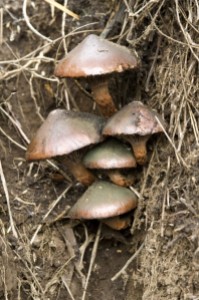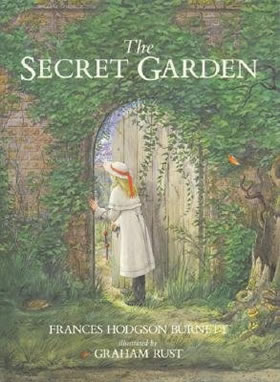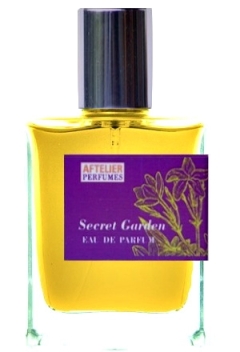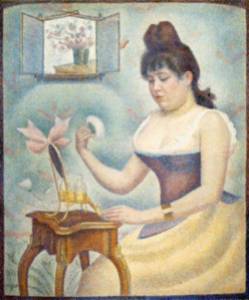As it might be clear by now, I’m focusing on florals this week with a series that began by looking at various treatments of tuberose. Like Goldilocks, we’re exploring the range from the fresh, green kind represented by Carnal Flower to the warmer, creamier interpretation of Moon Bloom, and, now, the darkest one of all. This last one is a wholly original, incredibly creative twist on the great white flower, turning it earthy with all the mushrooms and earth of the forest floor. It is Cepes and Tuberose (sometimes written as “Cepes & Tuberose” by others), a perfume with very woody, resinous, chocolate, cinnamon and dried rose elements to go along with the mushrooms.
Cepes and Tuberose was created by the highly respected, acclaimed all-natural perfumer, Mandy Aftel of Aftelier Perfumes. The perfume is classified as a fougère, which is a type of fragrance centered, in part, around herbs, along with more significant core components. Ms. Aftel has cleverly twisted the fresh, aromatic, herbal genre by taking a very different approach to the forest and mixing it with very different flowers. The critical component, however, are the cepes, a type of mushroom commonly referred to outside of France by its other name, porcini. Cepes and Tuberose comes in two concentrations: an eau de parfum concentration and in pure parfum. This review is for the former, the eau de parfum.
On her website, Ms. Aftel describes Cepes and Tuberose as follows:
Scent Family: Fougère
Wild mushrooms, with animal undertones and one of the world’s most voluptuous florals. Wild porcini mushrooms and Italian tuberose play a mysterious and earthy duet. One of my more enigmatic perfumes, it has won many awards and fans. — Chosen as one of “100 Perfumes Every Perfumista Should Try” by Now Smell This.Featured Notes
Top: bois de rose.
Heart: tuberose, Moroccan rose.
Base: cepes [or Porcini mushroom] absolute, benzoin.
Cepes and Tuberose opens on my skin with notes that strongly resemble sticky raisins, cinnamon infused fruits stewed in brown sugar molasses, and woods. There is also a very animalic leather component, followed by a truffle-like earthiness, then actual mushrooms with a hint of chocolate. The sweetened, plump, raisin molasses is infused with dark green herbs, aromatic but slightly smoky woods, and a mossy pungency. Within minutes, the latter takes on a medicinal, old-fashioned fougère tonality that has a very distant kinship to barber shops of old. Unlike those scents, however, Cepes and Tuberose is both sweetened and earthy.
The earthiness is interesting. Initially, it really feels more like humus (not hummus) which is the soil detritus of plants, dirt, leaves, and decaying organic matter. The mushroom tonality is subtle at first, more a suggestion than full-on porcinis. As regular readers know, one of my favorite discoveries last year was Oriza L. Legrand‘s ode to the forest floor, Chypre Mousse, an extremely green, mossy, mushroom, wet leaf and humus scent with herbal undertones, darkened resins and a wisp of leather. I love both the mushroom and earth note in Chypre Mousse, but it smells very different in Cepes and Tuberose. Here, it is not like sweet, loamy, wet soil, but a very dry one. There is sweetness, but it is of a brown sugar sap variety. Nothing in Cepes and Tuberose feels green or elfish, but dark, resinous, dry, and sweet. And the sense of something herbal, elemental and decayed feels much stronger here.
The rosewood adds a distinct element of dark, smoky woods, but also something that resembles pine sap. It’s a warm, not chilled, version of the note in Serge Lutens‘ Fille en Aiguilles. Actually, the Lutens fragrance that Cepes and Tuberose first brought to mind was Bois et Fruits. I think it’s due to the sticky raisin and spice accords, mixed with more autumnal woods. Yet, Cepes and Tuberose is much more leathered than either of those fragrances. It has a definite animalic component in the sense of muskiness, but it is never fecal, raw, sweaty or rank. It is more earthen, and infused with a sweetness that borders on cinnamon and chocolate.
10 minutes in, Cepes and Tuberose starts to change. The fragrance feels less medicinal, herbal, and animalic. The leather note fades to the background, while the earthy one turns more mushroomy. There is a surprising meatiness to it that made me think of Portobello mushrooms, but at this stage, it’s still only a mere suggestion. The more significant change is the introduction of the florals, and this is where I start to really struggle. On my skin, the flowers are dominated by an amorphous, rose note that strongly resembles spiced, dried, pressed rose petals and potpourri. I’m not generally a fan of roses, fresh or dried, but I have particular problems with potpourri.
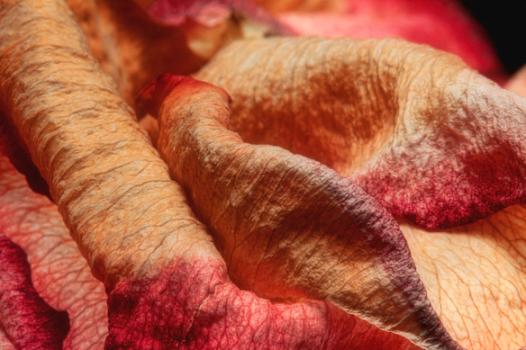
“Dried Rose Petals” by Tom Mc Nemar via Fineartamerica.
http://fineartamerica.com/featured/dried-rose-petals-ii-tom-mc-nemar.html
As time goes by, the rose potpourri takes over Cepes and Tuberose’s bouquet on my skin. The perfume smells increasingly like a very woody take on heavily spiced, cinnamon-dusted dried rose petals with an earthy humus note. Alas for me, the latter soon turns into hardcore porcini mushrooms, to a degree that Chypre Mousse never did. Actually, to be more precise, I smell like meaty, cooked portobellos dusted with cinnamon. The herbal green element has faded, though a certain pungency remains. The leathery note feels less musky, the raisins and brown sugar resin both weaken, and so does that subtle impression of pine. Their place is taken by a pinch of sweetened floral powder, presumably from the benzoin mingling with the roses.
I never once detected tuberose in its traditional, usual way. Instead, what slowly weaves its way through the notes is something that smells like a very browned gardenia. It strongly resembles the decayed gardenia in Serge Lutens‘ Un Voix Noire. As many of you know, gardenia is one of those flowers whose smell can’t really be captured from the petals, whose scent cannot be distilled, and whose aroma has to be recreated using other essential oils. (Fragrantica has a tiny bit on this issue if you’re interested.) Tuberose is one of the ways to recreate the smell of the gardenia, which may account for why the version in Cepes and Tuberose smells more like the latter than the former on my skin. Plus, gardenias naturally have a mushroomy scent when they are very ripe or close to the edge of decay.
On my skin, the browned “gardenia” is perhaps the most tertiary of notes, and everything is trumped by the cinnamon-infused dried roses. The cepes are like a Jack in the Box, popping up on occasion to say “Boo” before sinking back down. They feel less meaty at the end of the first hour, and are more dirt-covered with the lightest touch of a mossy undertone. None of it is easy for me, though I enjoy the new arrival on the scene: cocoa. The initial hint of something chocolate-like in the base has now risen to the surface, but it resembles semi-sweet, dry cocoa powder more than an actual block of heavy chocolate.
At the start of the second hour, Cepes and Tuberose is a bouquet of cinnamon-rose potpourri with coca-dusted dry woods on the surface, while a dark, decayed white floral and meaty portobello mushrooms lurk down below. It is simultaneously dry, dirty, dusty, sweet, sharp, spiced, pungent and soft — contradictory as some of those things may sound. It isn’t the easiest of scents for me, though I had a moment of hope about 1.75 hours into Cepes and Tuberose’s development. There, suddenly, there was an utterly lovely drydown of spiced warmth with cocoa powder, cinnamon benzoin, dried roses and a touch of sweet powder, all nestled in a dry-sweet embrace of cocoa-dusted woods. All the edges felt smoothed out, and the result was a delicious, quasi-gourmand that felt beautifully balanced. At times, there was even a subtle patchouli vibe (and you know how I love my patchouli).
Unfortunately, this stage was very brief on me, and I can only blame my skin. Something happened, and less than 30 minutes later, Cepes and Tuberose turned into the smell of dry dirt on me. Not sweet, loamy, wet soil, but very dry, old dirt, with touches of the other elements that I’ve described above. In its final moments, Cepes and Tuberose was nothing more than a blur of dryness that smelled vaguely like old dirt and potpourri. The whole thing lasted 4.75 hours with two small sprays, and 6.25 hours with a larger quantity. Generally, the sillage was very soft after an initially strong start, but Cepes and Tuberose was quite potent when smelled up close for a number of hours. In both my tests, it became a skin scent after 1.75 and 2.25 hours, depending on the quantity that I applied.
My struggles with Cepes and Tuberose really surprised me. Not only is tuberose my favorite flower in real life, but I love dark, woody, resinous or earthy scents. I certainly have no problems with humus or mushroom notes, as regular readers know from my ravings about Oriza’s Chypre Mousse. I can only chalk things up in this instance to skin chemistry and my personal tastes.
Others, however, have had much better luck with Cepes and Tuberose. Now Smell This has the perfume on its list of 100 things that every perfumista must try, calling it “dark, earthy and sexy.” Olfactoria of Olfactoria’s Travels who doesn’t like tuberose scents was actually driven to song, dance, and music, writing that the “deliciously intoxicating fumes” of the perfume brought out a part of her soul.
Meanwhile, Victoria of EauMG thought it was both sultry and akin to a chocolate-dipped pretzel, writing in part:
Cepes and Tuberose opens with sharp rosewood and hay. After this settles, it’s a big floral with blooming tuberose and dewy rose. It’s slightly sweet and lactonic but not too sweet or lactonic. It’s balanced by a savory saltiness. Think of it as the chocolate dipped pretzel of perfumes or even better yet, a peanut butter cup – a perfect balance of sweet and salty. The dry-down is an earthy yet sweet vanilla-benzoin. On my skin, the mushroom is rather faint. In fact, it is more like the animalic richness that is naturally present in “overripe” white florals. And because of this, Cepes and Tuberose is a rather sultry fragrance.
Perfume-Smellin’ Things found Cepes and Tuberose to be unique, and more akin to umami than to a tuberose scent. I think her umami comparison is extremely clever and astute:
Smelled on its own, tuberose absolute is as I know it, buttery, slightly mentholated and slightly rubbery. Smelled on its own, cepes absolute smells of soy sauce and red wine, a mouthwatering, “tongue-coating”, savory aroma. Smelled right after cepes, tuberose suddenly turns to me with a facet it hasn’t shown before … there is something in fact meaty there … meaty and dry and coated in earth…a certain piquant pungency that it took a mushroom to bring to light…or darkness, as it were.
The composition of Cepes & Tuberose is uncluttered. The two main ingredients are so rich, complex and charismatic, that any other notes have to be “quite simple. The cepes and the tuberose intertwined was all the star material that the perfume could aesthetically accommodate.” (M.Aftel) A little bit of citrus in the top notes brightens the fleshy dark brown of the blend; woods seem to both enhance the creaminess of tuberose and to add to the dry spiciness of porcini. This is undoubtedly one of the most unique tuberose perfumes – and much more than a tuberose perfume. It seems wrong to categorize it as a floral. But neither is it anything else really. It requires a new olfactory category of its own … Umami.
I think the review with which I agree the most is that of my friend, The Perfume Dandy, who accurately notes Ms. Aftel’s achievements in the vanguard of experimental, truly original, almost “avant garde” works in the olfactory plane. In terms of his actual experience with Cepes and Tuberose, he writes:
Cepes and Tuberose stands out for The Dandy as an idiosyncratic masterwork.
Meaty sweet mushrooms meet fleshy over ripe flowers in a carnal embrace that is splendidly earthy at the opening and morphs into an extraordinary splicing of library, forest and eccentric boudoir.
Truly original and quite remarkable.
This may not be a scent for everyone, but in a world of apparently endless choice (are there now more Angels in heaven or on the shelves of Thierry Mugler?) I, for one, am so glad that there are such creative options available.
I very much agree. Cepes and Tuberose isn’t the easiest of scents, and it isn’t for everyone. However, one must applaud Ms. Aftel for pushing the boundaries with something very unique. I have enormous respect for Ms. Aftel in general, but Cepes and Tuberose merely increases it, even if the scent did not work for me personally. To combine tuberose with fougère elements and to create an earthy tuberose with mushrooms… it is brilliantly original.

